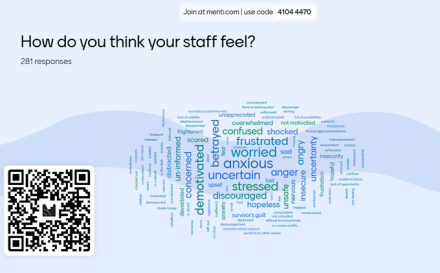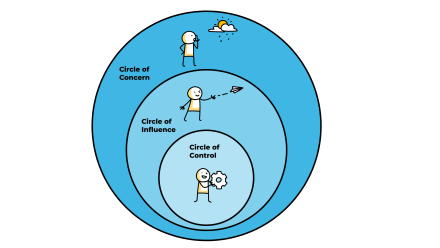
Leading teams in crisis: Reflections from the 'Shock and Shift' series
In a world of increasing volatility and uncertainty, the United Nations (UN) faces mounting fiscal risks and disruptive changes. Understanding the urgency of the situation, and to support colleagues navigating these challenges, UNSSC delivered ‘Shock and Shift,’ a series of webinars designed to build resilience, boost self-agency, and equip participants to respond effectively to sudden shifts and mitigate future risks.
During this process, approximately 400 team leaders, from across the system, came together and reflected on their leadership during the current disruptions and transformation of the UN system, where many organizations face severe budget cuts and plan significant downsizing. This blog reflects on how the current disruption is impacting staff, how team leaders matter, and how they can better support their teams to navigate this massive disruption.
Frustration and anxiety meet compassion and commitment
When asked how they feel, staff members in different functions and at different levels repeatedly used words like anxious, worried, uncertain, and frustrated throughout all webinars of the Shock and Shift series. Team leaders echoed these sentiments, describing widespread demotivation, disillusionment, and even emotional withdrawal. Morale is low, burnout is rising, and many feel resigned to a future they can no longer predict.

Despite this, leaders expressed admiration for their teams’ resilience. Many continue to work diligently, even while feeling overwhelmed. Compassion and camaraderie persist, though managing the unknown remains a major challenge—often described as more distressing than bad news itself.
A recurring theme is the sense that the system is unraveling. This perception makes it difficult for staff to focus, make decisions, or engage creatively. A perceived lack of transparency and clarity around future directions fuels concerns about fairness and equity was a repeated concern raised by participants.
One of the most pressing issues is a conceived disconnect between high-level announcements and their practical implications. Global town halls outline sweeping changes, but staff are left wondering how these shifts will affect their daily work, duty stations, contracts, and mandates. The absence of concrete answers only deepens the uncertainty.
Team leaders are often caught between a rock and a hard place as they are the ones facing questions from staff while they might be affected themselves and do not have the answers staff are seeking. At the same time, they shared examples on how they can make a difference for the climate in their teams


The following observations are based on experiences from team leaders shared through the Shock and Shift processes; tips from the UNLOCK team; as well as from Nancy Kline’s work: Time to Think and Hilary Scarlett’s work: Neuroscience for Organizational Change.
Team leaders matter
- Your state influences the emotional ‘weather’ of the team. So before responding to others, it is important for all team leaders to check in with themselves and acknowledge their own emotions.
- You are a walking signal. Every action, word, and gesture — even silence — communicates something. Being intentional in how each one shows up can help reduce uncertainty for your team.
- It is a trap to wait to communicate until you think you have all the information. This might never be the case in a constantly changing environment. The absence of leadership communication and engagement by leaders is replaced with water-cooler discussions, gossip and intense worrying.
- People don’t just need answers, they need understanding. Creating space for emotional expression and thoughtful dialogue builds trust and cohesion, even when you don’t have all the answers.
- Thinking environments matter. The way we treat one another while thinking — with attention, appreciation, and curiosity — shapes the quality of what emerges. Trust, appreciation, and attention help people move from freezing to focus.
Making a difference
Here are five practical tools, practices and processes to help your teams through disruption.
1. Combine clarity with compassion
“It’s not just about pensions and timelines.” - Shock and Shift participant
“We often overlook the difficulty of those who stay.” - Shock and Shift participant
Providing clear information is essential, but on its own, it’s not enough. When people are facing uncertainty, facts need to be accompanied by emotional presence. Staff who stays often have the survivor’s guilt and are affected by changes which impact people in their surroundings too. Leaders who pair transparent updates with genuine check-ins create a workplace where people feel both informed and seen. That balance fosters trust, resilience, and a stronger sense of belonging. Speak to the Head, to the Heart and to the Hands:
The Head is about logic and facts, e.g. the rationale for change or the criteria for cuts. The Heart needs the emotional impact acknowledged. Everyone wishes for strong agency, the sense that we can affect our life and exercise some control, which is represented by the Hand. Reflect with staff or your teams on what is a next step, something practical to do, which is under their control.
2. Lead with transparency to combat fear
“People need information, but they also need to feel it’s fair.” - Shock and Shift participant
“What’s the process for decision-making?” - Shock and Shift participant
By openly discussing what is known, what isn’t, and how decisions are made, leaders reduce speculation and strengthen trust. Fairness isn’t a luxury: it’s a survival need in organizations. You might not have all the facts or trust changing signals you receive from the top, still be clear what you know; what don’t know; and what you can and cannot speak about and influence.
3. Cultivate psychological safety through everyday leadership
“Help them feel as safe as you can. Not by giving false hope, but by standing beside them.” - Shock and Shift participant
“Recognize how hard this is.” - Shock and Shift participant
Being a human leader—not just a task manager—builds resilience and motivation in others. Acknowledging struggle can itself be a form of healing.
4. Create Thinking Environments that elevate everyone’s voice
“Don’t assume, listen to learn.” - Shock and Shift participant
“All ideas are good. Diversity raises intelligence.” - Shock and Shift participant
Whether in a hybrid or an in-person setting, give space for silence, ask twice, and ensure that everyone has the chance to contribute. Psychological safety isn’t spontaneous: it’s designed, it’s intentional.
These insights underscore that in times of upheaval; leadership isn’t just about strategy or control—it’s about presence. It means showing up with honesty, empathy, and courage, and cultivating a space where others feel safe to do the same.

5. Questions to shift your conversations
When morale is low and the team needs to remember their strengths: When did we last successfully deal with change? What did we do? What lessons are applicable for now?
When they are stuck: Where are you stuck right now? What do you need now/this week to move forward? How can I help?
When your team is concerned but not clear or specific about the impact of change: List all the consequences and issues that are you are anticipating due to confirmed or anticipated changes, Out of the entire list, what are the top one, two or three issues that we must address? What are mitigation strategies?
When your team is lost in discussions about problems beyond their reach: Ask them to list all their concerns. Then ask, what can we influence? What can we control?

We hope these webinars as part of the Shock and Shift series have provided the space and resource kit to unpack just a few consequences of the global shift, and given team leaders moments of reflection, self-care, and a renewed possibility to practice mindful leadership – in times when uncertainty is the only certainty.
This blog is written by Sabine Bhanot with Eloy Llevat Soy and Natalia Kawana based on the discussion of more than 400 team leaders in four ‘Shock and Shift’ webinars, conceived by the UNSSC Knowledge Centre for Leadership and Management (KCLM) and designed with its UN Lab for Organizational Change and Knowledge (UNLOCK) in April and May 2025.


